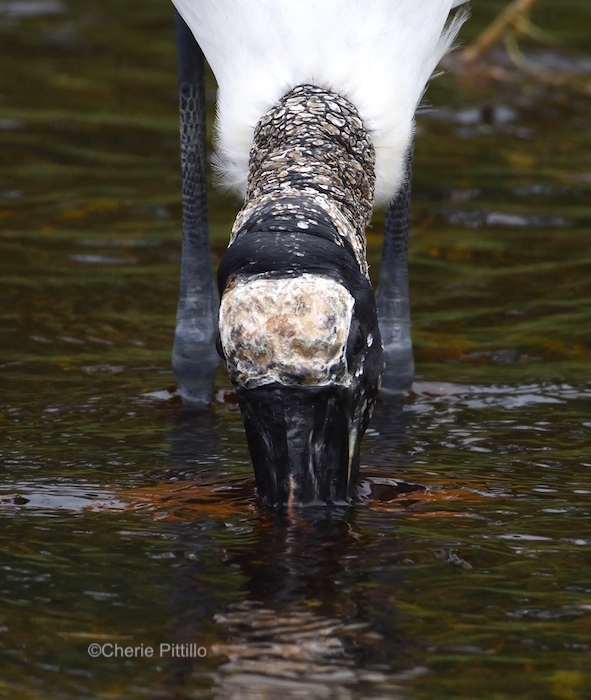Wood Stork Mycteria americana Cigüeña Americana o Galletán (Spanish)
When I saw an adult Wood Stork standing still with its open bill submerged in grasses in water, I wondered if it were somehow stuck in the muck.

While I used my car as an early morning blind at this roadside ditch and culvert intersection in Florida, I surveyed all the Wood Storks I could see in the area. Most lounged on the ditch bank, but six storks also stood like statues with their bills partly or mostly submerged for several minutes and then repeated the stance. Occasionally they would reposition their bill or stir the water with one foot as they resumed their rigid position. A heavy recent rainfall resulted in water rushing into the culvert. Both adults and immatures did the statue pose.

Typically Wood Storks step slowly forward while moving their open bill in front of them or side to side in freshwater or estuarine habitats. This technique, tachtolocation or grope feeding, helps when prey isn’t visible such as at night, in muddy or turbid waters, or in thick vegetation. Whenever prey touches the bill’s interior, it snaps shut quicker than the eye blink of a human. Although storks are tactile feeders and don’t need to see their prey, records indicate flying storks spotted sick catfish swimming at the water’s surface and dined on them.
As it walks, the stork often raises it foot, flexes its pink toes, then puts it down in the water and stirs up whatever is there. Perhaps those dark pink toes in breeding season and slightly pink toes at other times resemble juicy prey to the fish. Or maybe those pinkies just scatter those critters toward that waiting bill trap.


Another method to entice or startle prey is when it flicks and holds one wing outward or less often both wings while it walks. Perhaps the wing-flicking is not so much for balance as it may scare prey or even provide shade that a fish might swim to for cover.


Often these storks feed while other wading birds feed beside or near them. The stork statues did not move from their location even when other birds were close such as the Snowy Egret or a Roseate Spoonbill. I often see spoonies feeding with the storks in ponds, ditches, and canals and surmise both help scatter prey toward each other.



Although prey items are mostly 1-6 inch fish, their menu seems to include any critter it can catch in the water or even in nearby vegetation. Research lists snails, crayfish, grass shrimp, crabs, frogs and tadpoles, snakes, small alligators, young birds, woodrats, mice, and shrews. Plant material and insects may be consumed accidentally during the capture. Even dead fish are devoured. In another study of manmade canals and ditches tadpoles became their main menu item.

Why were the storks standing still? Did I happen to observe an uncommon feeding strategy or were they actually cooling themselves?
I met a Park Ranger who suggested it was cooling behavior. Other bird experts have never seen this and have observed these birds for 40 years!
When a Wood Stork is hot, it cools off by excreting waste onto its legs as white uric acid paste. As the water in that excretion evaporates, it cools off the bird. I know you’re thinking “Ewww!” but birds don’t have sweat glands. Besides, it looks as if they sport kinky boots! I photographed these “boots” near a rookery.

Remember I mentioned several storks lounged on the bank? I didn’t see any whitish legs due to excrement during this cool morning. Since I did see the occasional foot stirring, I’m leaning towards a feeding strategy.
UPDATE: Through email correspondence, I contacted Dr. Paul Gray, Audubon Florida Everglades Science Coordinator. He stated “…Fish will swim to running water (as all fishermen know) and they were likely waiting for the fish to come to them, rather than feel around for them.”
If so, that’s a lazy way to catch fish! Or a smart, energy efficient one!

PHOTO 13
SPREAD YOUR WINGS AND STIR UP SOME TIME TO DISCOVER NATURE’S GIFTS
For this holiday season, may there be peace, respect, and tolerance for all:
MERRY CHRISTMAS, FELIZ NAVIDAD, HAPPY HANUKKAH, HAPPY KWANZAA, BUONE FESTE NATALIZIE, KURISUMASU OMEDETO, JOYEUX NOEL, FROEHLICHE WEIHNACHTEN, FELIZ NATAL, KRISMASI NJEMA, SAWAT DEE WAN, AND HAPPY HOLIDAYS
DISCLAIMER: References do not agree about this information.
Sal a Pajarear Yucatán, Birds & Reserves of the Yucatan Peninsula, The Sibley Guide to Birds
email correspondence, Dr. Paul Gray
https://birdsoftheworld.org/bow/species/woosto/cur/foodhabits
https://www.allaboutbirds.org/guide/Wood_Stork/lifehistory
https://www.fpl.com/environment/pdf/wood-stork.pdf
https://www.ncbi.nlm.nih.gov/pmc/articles/PMC7441144/
https://www.fws.gov/verobeach/msrppdfs/woodstork.pdf
https://www.fws.gov/panamacity/resources/WSbrochure.pdf
http://dpanther.fiu.edu/sobek/FI14090852/00001
https://birdsoftheworld.org/bow/species/woosto/cur/introduction
Cherie Pittillo, “nature inspired,” photographer and author, explores nature everywhere she goes. She’s identified 56 bird species in her Merida, Yucatan backyard view. Her monthly column features anecdotes about birding in Merida, Yucatan and also wildlife beyond the Yucatan.
Contact: [email protected] All rights reserved, ©Cherie Pittillo




3 comments
I’m curious: Why are the stork’s head featherless? It makes sense for vultures dining on decomposing carcass. But storks don’t get messy head feathers in their feeding habits.
J. Dan Pittillo. Juvenile birds have feathers but lose them as they become adults. Those black, leathery-looking parts you see on the adults can be extended probably during aggression and maybe for courtship.
So interesting! Very clever of the storks to have figured this out. I would like a better answer to Dan’s question. Most bare headed birds eat carrion and don’t want bloody feathers, but do you think wood storks and turkeys have bare heads just for displaying?